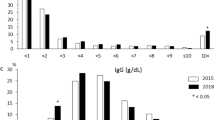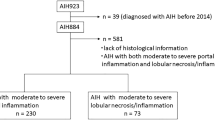Abstract
Background
A nationwide survey of autoimmune hepatitis (AIH) patients was performed in Japan in 2015. The aims of this study were to elucidate the trends and characteristics of AIH in Japan, in addition to identifying differences in AIH between acute hepatitis and chronic hepatitis.
Methods
Questionnaires about patients with AIH diagnosed from 2009 to 2013 were sent to 437 hospitals or clinics with hepatology specialists.
Results
A total of 1682 patients were enrolled. The mean age at diagnosis was 60.0 years, and 87.1 % of patients were female. Serum immunoglobulin G levels were high, peaking at 1.5–2.0 g/dL. Histological diagnoses of chronic hepatitis, acute hepatitis, and cirrhosis were seen in 79.6, 11.7, and 6.7 % of patients respectively. In addition to elevation of aminotransferase levels, the frequencies of emperipolesis and human leukocyte antigen (HLA)-DR2 positivity were higher in patients with acute hepatitis than in those with chronic hepatitis. Approximately 80 % of patients were treated with corticosteroids, and in 97.7 % of them, their condition improved. Steroid pulse therapy was more frequently given to patients with acute hepatitis than to those with chronic hepatitis.
Conclusions
In the present nationwide survey of AIH patients in Japan, patients with acute hepatitis had clinical features different from those of patients with chronic hepatitis.



Similar content being viewed by others
References
Johnson PJ, McFarlane IG. Meeting report: International Autoimmune Hepatitis Group. Hepatology. 1993;18:998–1005.
Alvarez F, Berg PA, Bianchi FB, et al. International Autoimmune Hepatitis Group report: review of criteria for diagnosis of autoimmune hepatitis. J Hepatol. 1999;31:929–38.
Hennes EM, Zeniya M, Czaja AJ, et al. Simplified criteria for the diagnosis of autoimmune hepatitis. Hepatology. 2008;48:169–76.
Monna T, Kuroki T, Yamamoto S. Autoimmune hepatitis: the present status in Japan. Gastroenterol Jpn. 1985;20:260–72.
Onji M, Nonaka T, Horiike N, et al. Present status of autoimmune hepatitis in Japan. Gastroenterol Jpn. 1993;28(Suppl 4):134–8.
Toda G, Zeniya M, Watanabe F, et al. Present status of autoimmune hepatitis in Japan-correlating the characteristics with international criteria in an area with a high rate of HCV infection. J Hepatol. 1997;26:1207–12.
Abe M, Mashiba T, Zeniya M, et al. Present status of autoimmune hepatitis in Japan: a nationwide survey. J Gastroenterol. 2011;46:1136–41.
Onji M, Zeniya M, Yamamoto K, et al. Autoimmune hepatitis: diagnosis and treatment guide in Japan, 2013. Hepatol Res. 2014;44:368–70.
Ohira H, Abe K, Takahashi A, et al. Recent advances in the pathogenesis and new diagnostic guidelines in Japan. Intern Med. 2015;54:1323–8.
Wong RJ, Gish R, Frederick T, et al. The impact of race/ethnicity on the clinical epidemiology of autoimmune hepatitis. J Clin Gastroenterol. 2012;46:155–61.
van Gerven NM, Verwer BJ, Witte BI, et al. Epidemiology and clinical characteristics of autoimmune hepatitis in the Netherlands. Scand J Gastroenterol. 2014;49:1245–54.
Delgado JS, Vodonos A, Malnick S, et al. Autoimmune hepatitis in southern Israel: a 15-year multicenter study. J Dig Dis. 2013;14:611–8.
Kim BH, Kim YJ, Jeong SH, et al. Clinical features of autoimmune hepatitis and comparison of two diagnostic criteria in Korea: a nationwide, multicenter study. J Gastroenterol Hepatol. 2013;28:128–34.
Tiniakos DG, Brain JG, Bury YA. Role of histopathology in autoimmune hepatitis. Dig Dis. 2015;33(Suppl 2):53–64.
Harada K. Histological findings of autoimmune hepatitis. In: Ohira H, editor. Autoimmune liver disease: perspectives from Japan. Tokyo: Springer Japan; 2014. p. 45–65.
Czaja AJ, Doherty DG, Donaldson PT. Genetic bases of autoimmune hepatitis. Dig Dis Sci. 2002;47:2139–50.
Miyake Y, Iwasaki Y, Takaki A, et al. Human leukocyte antigen DR status and clinical features in Japanese patients with type 1 autoimmune hepatitis. Hepatol Res. 2008;38:96–102.
Manns MP, Czaja AJ, Gorham JD, et al. Diagnosis and management of autoimmune hepatitis. Hepatology. 2010;51:2193–213.
Ohira H, Abe K, Takahashi A, et al. Clinical features of hepatocellular carcinoma in patients with autoimmune hepatitis in Japan. J Gastroenterol. 2013;48:109–14.
Yoshizawa K, Joshita S, Matsumoto A, et al. Incidence and prevalence of autoimmune hepatitis in the Ueda area, Japan. Hepatol Res. 2016;46:878–83.
Acknowledgments
This study was conducted and supported by Health Labor Science Research grants from Research on Measures for Intractable Diseases, the Intractable Hepato-Biliary Diseases Study Group in Japan.
In addition to the authors, the hepatology specialists who participated in this study and the contributors to this study were as follows: Masahito Minami (Aiseikai Yamashina Hospital), Hikaru Nagahara (Aoyama Hospital Tokyo Women’s Medical University), Shiro Yokohama (Asahikawa Medical Center), Koji Sawada (Asahikawa Medical University), Takato Ueno (Asakura Medical Association Hospital), Yuki Haga (Chiba University), Chiharu Miyabayashi (Chikuma Central Hospital), Masaya Tamano (Dokkyo Medical University Koshigaya Hospital), Yasuaki Takeyama (Fukuoka University), Kenji Imai (Gifu University Hospital), Yuichi Yamazaki (Gunma University Hospital), Kazuhito Kawata (Hamamatsu University School of Medicine), Hiroshi Aikata (Hiroshima University Hospital), Koji Ogawa (Hokkaido University), Shuhei Nishiguchi (Hyogo College of Medicine), Akihide Masumoto (Iizuka Hospital), Toshihiko Mizuta (Imari Arita Kyoritsu Hospital), Kojiro Kataoka (Iwate Medical University School of Medicine), Chitomi Hasebe (Japanese Red Cross Asahikawa Hospital), Hiroshi Watanabe (Japanese Red Cross Fukuoka Hospital), Hideki Fujii (Japanese Red Cross Kyoto Daiichi Hospital), Hiroo Fukada (Juntendo University Nerima Hospital), Kazuyoshi Kon (Juntendo University School of Medicine),Takuya Genda (Juntendo University Shizuoka Hospital), Takako Nomura (Kagawa University Hospital), Mikihiro Tsutsumi (Kanazawa Medical University), Miki Murata (Kansai Medical University Medical Center), Kazuya Kitamura (Kanazawa University Hospital), Nobuko Koyama (Kawasaki Medical School), Shinji Iwasaki (Kochi University), Takeshi Kawasaki (Kumamoto University Hospital), Kouju Kobayashi (Kurihara Central Hospital), Hitoshi Takagi (Kusunoki Hospital), Yuya Seko (Kyoto Prefectural University of Medicine), Yuki Bekki (Kyushu University), Shinji Shimoda (Kyushu University Hospital), Hisashi Takayama (Maebashi Red Cross Hospital),Yasuyuki Nagao (Matsushita Memorial Hospital), Toshie Mashiba (Matsuyama Red Cross Hospital), Kiyohiko Kishi (Meiwa General Hospital), Naoya Murashima (Mishuku Hospital), Motoshige Nabeshima (Mitsubishi Kyoto Hospital), Akihiro Obora (Murakami Memorial Hospital Asahi University), Atsumasa Komori (Nagasaki Medical Center), Hidetaka Shibata (Nagasaki University Hospital), Yasuyo Morita (Nagata Hospital), Saiyu Tanaka (Nara City Hospital), Kei Moriya (Nara Medical University), Kengo Tomita (National Defense Medical Colledge Hospital), Toshiki Yamamoto (Nihon University Hospital), Kentarou Igarashi (Niigata City General Hospital), Satoshi Yamagiwa (Niigata University), Daisuke Watanabe (Noshiro Yamamoto Medical Association Hospital), Akira Kaneko (NTT Osaka Hospital), Shinya Yokoyama (Ogaki Municipal Hospital), Tomohiko Suzuki (Ohkubo Hospital), Shinichi Fujioka (Okayama Saiseikai General Hospital), Mie Arakawa (Oita University Hospital), Kazunori Noguchi (Omuta City Hospital), Norifumi Kawada (Osaka City University Graduate School of Medicine), Takatoshi Nawa (Osaka Medical Center for Cancer and Cardiovascular Diseases), Hideko Ohama (Osaka Medical College Hospital), Kunimaro Furuta (Osaka University), Shiro Takami (Otsu Municipal Hospital), Taiga Otsuka (Saga University Hospital), Atsushi Nakazawa (Saiseikai Central Hospital), Morikazu Onji (Saiseikai Imabari Hospital), Shigeru Matsui (Saiseikai Kawaguchi General Hospital), Fujimasa Tada (Saiseikai Matsuyama Hospital), Sumiko Nagoshi (Saitama Medical Center), Mie Inao (Saitama Medical University), Yoshinori Horie (Sanno Medical Center), Tomoaki Nakajima (Sapporo-Kosei General Hospital), Hideyasu Takagi (Sapporo Medical University Hospital), Takeji Umemura (Shinshu University School of Medicine), Toshiyuki Baba (Showa University Northern Yokohama Hospital), Naoki Yamashita (Steel Memorial Yawata Hospital), Hiroshi Okano (Suzuka General Hospital), Atsushi Naganuma (Takasaki General Medical Center), Kentaro Kikuchi (Teikyo University Hospital, Mizonokuchi), Kazuhiko Koike (The Jikei University Daisan Hospital), Yoshio Aizawa (The Jikei University Katsushika Medical Center), Shougo Ohkoshi (The Nippon Dental University), Ryo Nakagomi, Tomohiro Tanaka (The University of Tokyo Hospital), Mie Shinohara (Toho University Omori Medical Center), Yutaka Miyazaki (Tohoku Kosai Hospital), Yu Nakagome (Tohoku University Hospital), Mitsunori Morimatsu (Tokuyama Medical Association Hospital), Tadashi Ikegami (Tokyo Medical University Ibaraki Medical Center), Naoaki Hashimoto (Tokyo Teishin Hospital), Masahiko Koda (Tottori University Hospiital), Tomoyuki Nemoto (University of Fukui Hospital), Masami Minemura (Toyama University Hospital), Yoshiyuki Mori (Wakayama Medical University), Kazuo Okumoto (Yamagata University), Yasuhiro Funayama (Yamagata City Hospital SAISEIKAN), Isao Hidaka (Yamaguchi University), Noriyuki Ono (Yame General Hospital), Takaaki Ikeda (Yokosuka Kyosai Hospital).
Author information
Authors and Affiliations
Consortia
Corresponding author
Ethics declarations
Conflict of interest
Yoshiyuki Suzuki received lecture fees from Bristol-Myers Squibb. The other authors declare that they have no conflict of interest.
Additional information
The authors in the Autoimmune Hepatitis Study Group, a subgroup of the Intractable Hepato-Biliary Disease Study Group in Japan, are listed in “Acknowledgments.”
Rights and permissions
About this article
Cite this article
Takahashi, A., Arinaga-Hino, T., Ohira, H. et al. Autoimmune hepatitis in Japan: trends in a nationwide survey. J Gastroenterol 52, 631–640 (2017). https://doi.org/10.1007/s00535-016-1267-0
Received:
Accepted:
Published:
Issue Date:
DOI: https://doi.org/10.1007/s00535-016-1267-0




